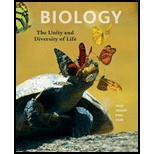
Organic molecules consist mainly of ______ atoms.
- a. carbon
- b. carbon and oxygen
- c. carbon and hydrogen
- d. carbon and nitrogen
Introduction: The molecules that are majorly composed of carbon and hydrogen are classified by chemists as organic molecules. The basis of life is the organic compounds that make it up. Organic chemistry is the study of these compounds. The methodology of synthesis of these compounds is called as organic synthesis.
Answer to Problem 1SQ
Correct answer: The organic compounds are those that consist majorly of carbon and hydrogen atoms. Hence, the correct answer is option c.
Explanation of Solution
Reason for correct answer:
The living organisms are composed of several molecules. They are called as molecules of life. The molecules of life include carbohydrates, fats, proteins, nucleic acids, and many more. They are made of organic molecules, which mainly consist majorly of carbon and hydrogen atoms. The organic molecules also have oxygen, nitrogen, sulphur, and phosphorus atoms in a minor form. These organic molecules are also found in the non-living things.
Option c. is given as “carbon and hydrogen”.
The organic compounds consist mainly of both carbon and hydrogen atoms that are present in different proportions to form various functional groups.
Hence the correct answer is option c.
Reason for incorrect answer:
Option a. is given as “carbon”.
Though the carbon atoms majorly constitute the organic compounds, chemists define organic compounds as those with both carbon and hydrogen atoms. Hence, option a. is incorrect.
Option b. is given as “carbon and oxygen”.
Certain organic molecules like carboxylic acids, carbonyl functions groups, aldehyde groups, and ketone groups contain both carbon and oxygen atoms; oxygen is present in lesser amount than hydrogen. Hence, option b. is incorrect.
Option d. is given as “carbon and nitrogen”.
Certain organic molecules like amino acids, nucleic acids, phospholipids, amides, amines, nitrile, and imine functional groups. Hence, option d. is incorrect.
Hence the options a., b., and d are incorrect.
Want to see more full solutions like this?
Chapter 3 Solutions
Biology: The Unity and Diversity of Life (MindTap Course List)
Additional Science Textbook Solutions
The Cosmic Perspective (8th Edition)
HUMAN ANATOMY
Campbell Essential Biology (7th Edition)
Genetics: From Genes to Genomes
Biology: Life on Earth with Physiology (11th Edition)
- What did the Cre-lox system used in the Kikuchi et al. 2010 heart regeneration experiment allow researchers to investigate? What was the purpose of the cmlc2 promoter? What is CreER and why was it used in this experiment? If constitutively active Cre was driven by the cmlc2 promoter, rather than an inducible CreER system, what color would you expect new cardiomyocytes in the regenerated area to be no matter what? Why?arrow_forwardWhat kind of organ size regulation is occurring when you graft multiple organs into a mouse and the graft weight stays the same?arrow_forwardWhat is the concept "calories consumed must equal calories burned" in regrads to nutrition?arrow_forward
- You intend to insert patched dominant negative DNA into the left half of the neural tube of a chick. 1) Which side of the neural tube would you put the positive electrode to ensure that the DNA ends up on the left side? 2) What would be the internal (within the embryo) control for this experiment? 3) How can you be sure that the electroporation method itself is not impacting the embryo? 4) What would you do to ensure that the electroporation is working? How can you tell?arrow_forwardDescribe a method to document the diffusion path and gradient of Sonic Hedgehog through the chicken embryo. If modifying the protein, what is one thing you have to consider in regards to maintaining the protein’s function?arrow_forwardThe following table is from Kumar et. al. Highly Selective Dopamine D3 Receptor (DR) Antagonists and Partial Agonists Based on Eticlopride and the D3R Crystal Structure: New Leads for Opioid Dependence Treatment. J. Med Chem 2016.arrow_forward
- The following figure is from Caterina et al. The capsaicin receptor: a heat activated ion channel in the pain pathway. Nature, 1997. Black boxes indicate capsaicin, white circles indicate resinferatoxin. You are a chef in a fancy new science-themed restaurant. You have a recipe that calls for 1 teaspoon of resinferatoxin, but you feel uncomfortable serving foods with "toxins" in them. How much capsaicin could you substitute instead?arrow_forwardWhat protein is necessary for packaging acetylcholine into synaptic vesicles?arrow_forward1. Match each vocabulary term to its best descriptor A. affinity B. efficacy C. inert D. mimic E. how drugs move through body F. how drugs bind Kd Bmax Agonist Antagonist Pharmacokinetics Pharmacodynamicsarrow_forward
 Concepts of BiologyBiologyISBN:9781938168116Author:Samantha Fowler, Rebecca Roush, James WisePublisher:OpenStax College
Concepts of BiologyBiologyISBN:9781938168116Author:Samantha Fowler, Rebecca Roush, James WisePublisher:OpenStax College
 Biology (MindTap Course List)BiologyISBN:9781337392938Author:Eldra Solomon, Charles Martin, Diana W. Martin, Linda R. BergPublisher:Cengage Learning
Biology (MindTap Course List)BiologyISBN:9781337392938Author:Eldra Solomon, Charles Martin, Diana W. Martin, Linda R. BergPublisher:Cengage Learning Human Biology (MindTap Course List)BiologyISBN:9781305112100Author:Cecie Starr, Beverly McMillanPublisher:Cengage Learning
Human Biology (MindTap Course List)BiologyISBN:9781305112100Author:Cecie Starr, Beverly McMillanPublisher:Cengage Learning Biology: The Unity and Diversity of Life (MindTap...BiologyISBN:9781337408332Author:Cecie Starr, Ralph Taggart, Christine Evers, Lisa StarrPublisher:Cengage Learning
Biology: The Unity and Diversity of Life (MindTap...BiologyISBN:9781337408332Author:Cecie Starr, Ralph Taggart, Christine Evers, Lisa StarrPublisher:Cengage Learning





